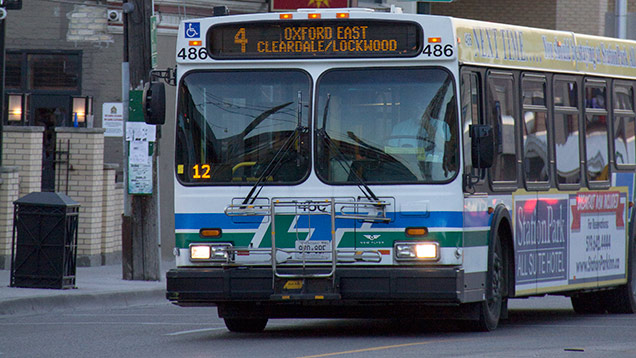Late to class: The downs of the London Transit Commission
 CREDIT: CANDIS BROSS
CREDIT: CANDIS BROSSBus-riders have concerns, but the LTC will try to make ammends this year.
If there’s one thing Londoners like more than London Knights hockey games, it’s complaining about their bus service; but it’s easy to complain about something when you have nothing to compare it to.
Looking at similar-sized cities such as Hamilton and Waterloo, the London Transit Commission (LTC) not only runs more frequently, but also has to accommodate a considerably higher ridership with a minimal bus fleet, according a draft report published in March, which outlines route structure and service guidelines.
The LTC has been constantly revamping and improving its services thanks to John Ford, director of Planning and Transportation. Ford has been spearheading the five-year route and service plan, which has been devised to combat consistent overcrowding on busses.
“The system was essentially broke,” Ford said. “We needed to take transit to the next level, we needed to come up with a way to move busses more efficiently.”
One of the main issues causing overcrowding within the city is that London’s bus force is running on 30 fewer vehicles than cities with similar populations, forcing the LTC to make an additional 1.5 million trips each year, according to the draft report.
While the 2015 route review claims, “The load profile data did not identify any corridors where the peak passenger load exceeded capacity,” students may miss busses due to overcrowding on post-secondary routes – with upwards of three busses passing over the stops nearest campuses.
Despite this, the report, which analyzed 10 popular routes heading to Western and to Fanshawe, showed the average capacity during peak hours to be only 53 per cent. When talking with students, many confirmed that the overcrowding issues are far worse in the morning hours. The report, however, omitted data concerning this time frame, and instead published its numbers based on the afternoon rush.
While there are discrepancies between published data and public complaints, Ford says change is coming.
“In 2016, we’re impacting about 50,000 hours of service on an annual basis and we’re reinvesting that into the system; so there’s 50,000 hours of changes – 17,000 of those are new,” he said. “ [We’re] looking at improving some of the late evening services; the late evening Saturday, the Sunday services, those services that have currently a 60-minute frequency.”
This leads to another issue with London’s transit; short daily service span and infrequent to non-existent Sunday services. While other cities in the draft report are running busses from 5 a.m. till after midnight, LTC runs from 6 a.m. till midnight on weekdays, with shorter service hours on Sundays.
This can make commuting to and from work difficult for many Londoners and causes issues for students who count on weekend hours for the bulk of their income. Unlike the overcrowding issues, these problems haven’t gone completely unnoticed. The newly proposed draft schedule would see the service span running from 5 a.m. to 1 a.m. Monday to Saturday, and 7 a.m. to midnight on Sundays.
Many of these issues will be addressed over the next five years as London’s ridership continues to grow. Each year LTC holds public forums in April where citizens can meet with officials and voice any concerns they may have.














